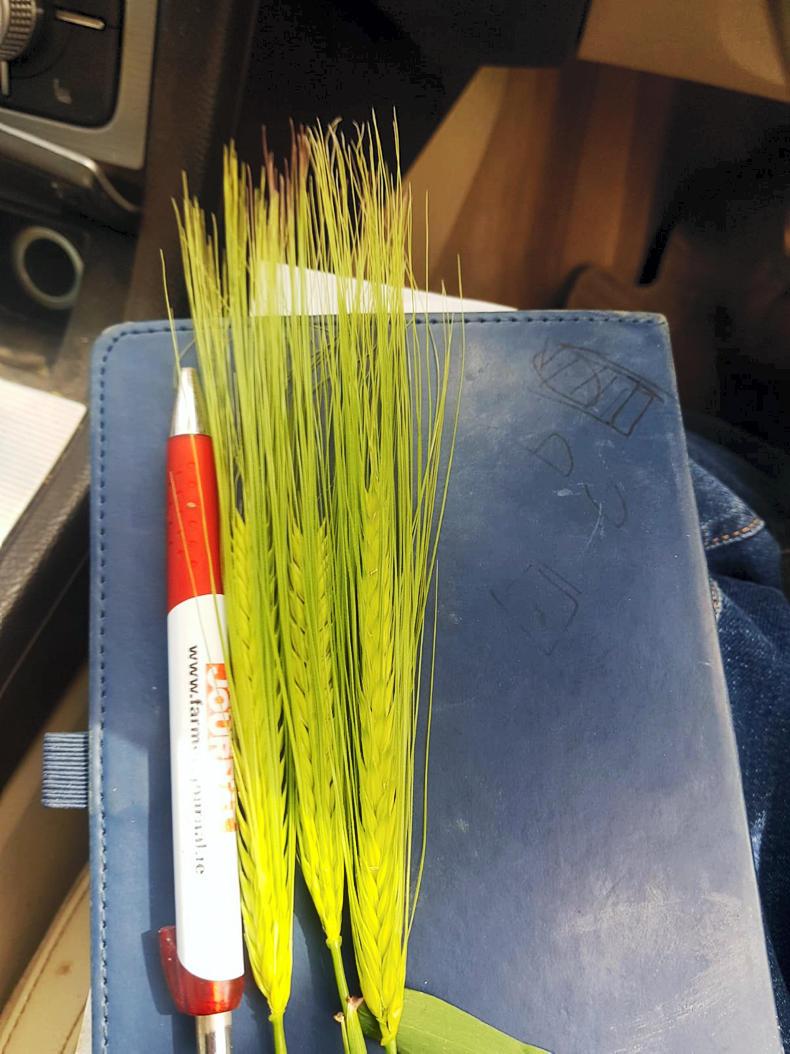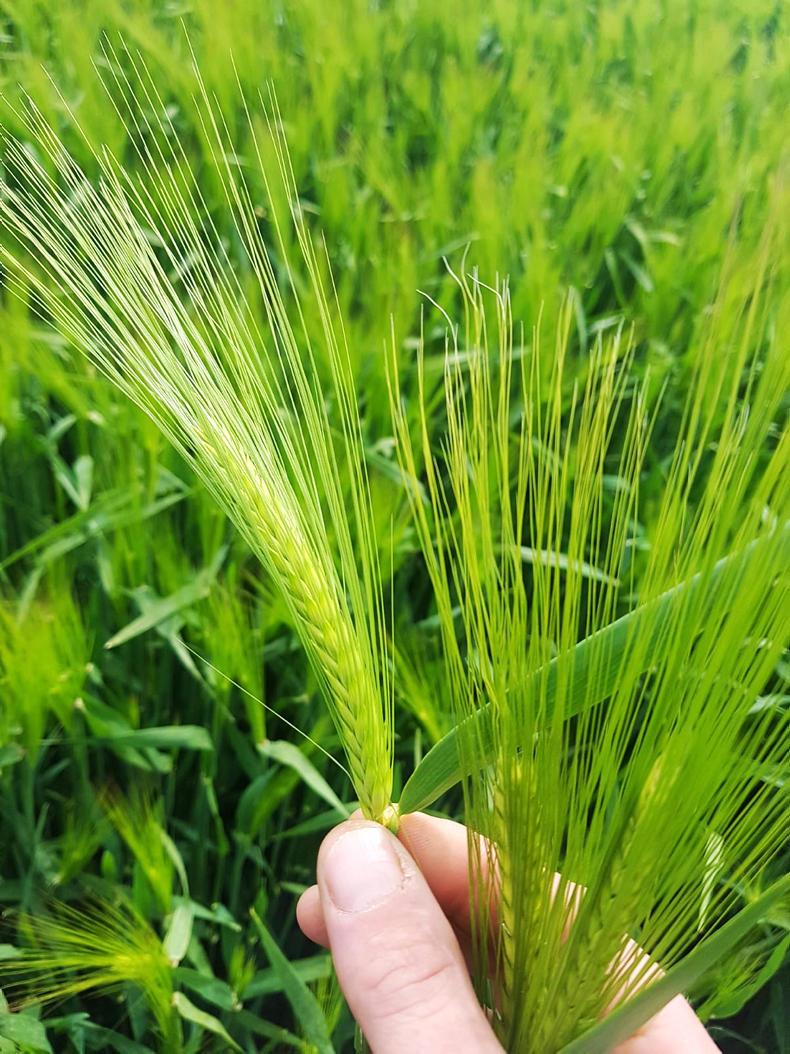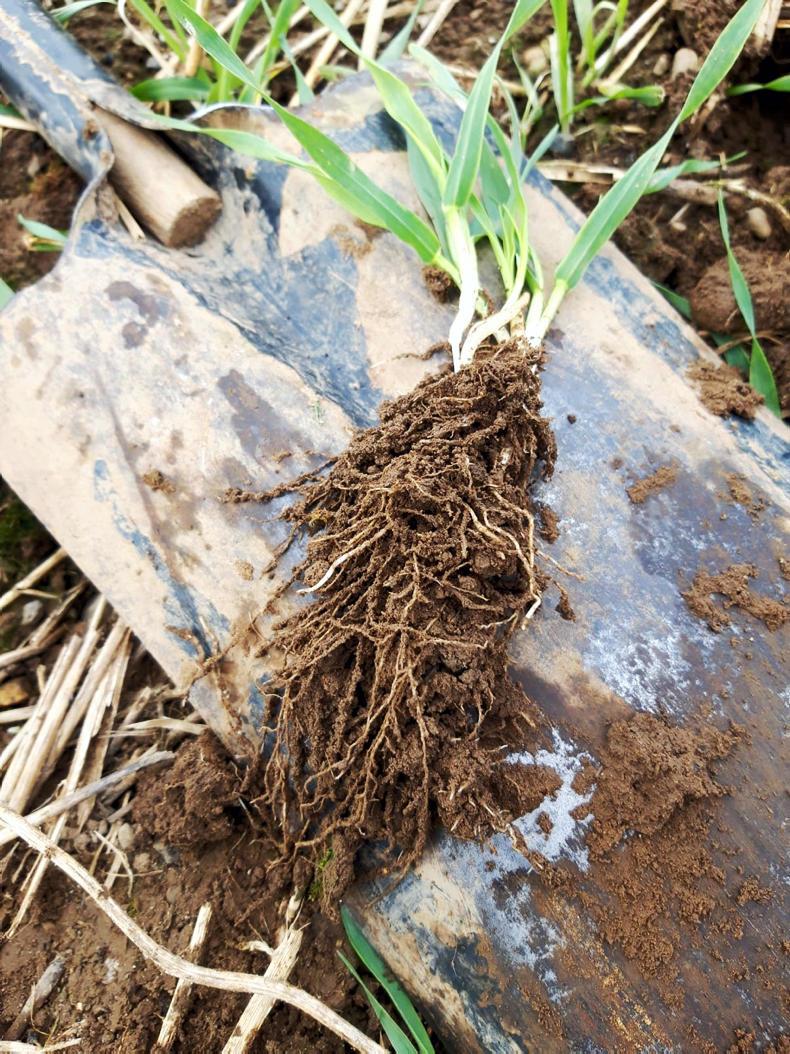Ballyragget,
Co Kilkenny
Conditions for field work have been good on James’ farm. Around 52mm of rain in Ballyragget since we last spoke with him. However on average, temperatures have been cool, which has slowed down crop development.

The emerged head of Jame's hybrid winter barley this week.
Flag leaf emergence in his winter wheat currently ranges from 30-100% out. In terms of septoria pressure his Costello crop is the cleanest, while his JD Diego crop has the highest levels of infection. With that said, overall disease pressure is minimal. The crop will receive its T2 at the end of the week. His wheat following oilseed rape was brought up to 206kg N/ha while crops following oats were brought up to 230kg N/ha last week.
He left the interval between splits for as long as he could in order to allow the crop to take up the nitrogen. This is critical in order to get the best use of his Yara N sensor.
Head spray
The head on his hybrid winter barley is fully emerged and the crop received a T3 last week of Splice (0.9l/ha) and Bravo (1l/ha) as well as 2.5kg/ha of Epsom salts. The crop remains very clean, helped by the good disease resistant profile of the hybrid varieties. The flag leaf is fully out in his winter oats and he expects the head to emerge next week. Over four weeks have passed since its T1 application, so James decided to split his T2. He applied Opus Team (0.75l/ha) on the flag leaf as a holding spray and will apply a SDHI on the head once fully emerged. There is a touch of purple blotching in the canopy, but apart from this the crop is clean.

The emerged head of Jame's hybrid winter barley this week.
The petals are currently falling in his oilseed rape crop. The crop is a hard one to judge explains James, but there appears to be good yield potential this year.
Orders for new season straw have once again picked up in the area and initial indications suggest prices will be around €20/4x4 round bales this year.
James remains on budget this year in terms of input expenditure on crops, with savings being made on reduced nitrogen usage.
Athy, Co Kildare
With night time temperatures dipping below 0°C for four nights last week, crop development has slowed down considerably on Andrew’s farm.
Awns are just emerging on his winter barley, which would be somewhat late compared to normal. “There’s a head there waiting to come out, you would have to ask if it is adjusting the number of grain sites to fill as the temperatures were so cold” he remarks.

Andrew's early-sown barley is rooting well.
His crop received a T1 application on 5 April and will receive a T2 head spray later this week. Despite the long interval, crops remain clean but there is BYDV present to varying degrees. This ranges from yellow leaves to thinner, stunted crops. The seed wasn’t dressed and the crop didn’t receive an aphicide. “We’ll see what happens when the combine goes through it and see what we learn from this,” he explained.
He expects to apply a barley pack containing Deuce (0.8l/ha) and Diamond (0.8l/ha) as well as boron and manganese trace elements to the crop this week.
His Cellule winter wheat is racing ahead. With ears emerging, the crop is on par with winter barley timings. The crop received a flag leave spray at the start of May consisting of Librax (1.8l/ha) and Bravo (1.0l/ha). The crop is clean and rates moderately well for septoria and rust resistance.
His winter oats are developing slowly, but Andrew is happy with their progress. There was some mildew present on the crop earlier in the spring which proved more challenging than expected to control. His early sown spring barley crops received an early fungicide application of Comet (0.63l/ha) and Decoy (0.63l/ha) as there was net blotch present in the crop.
Andrew is questioning whether he has to apply an aphicide onto his later sown spring barley crop due to his experiences of winter barley this year. From inspections, aphids are not present in big numbers. The crops were sprayed with Cameo (45g/ha) and Galaxy (0.5-1l/ha) on 19 April.
He had to apply Axcela slug pellets (7kg/ha) onto some of his spring barley and pea crops, as slug numbers were higher than anticipated.
Bushmills,
Co Antrim
A great month of weather has seen Mark finish potato planting 10 days earlier than last year. Just 36.1mm of rain has fallen since we last spoke to Mark. That said, temperatures have been cool and this has slowed down emergence and development of his potatoes, he explains. However, with highs of 20°C this week, growth has once again recommenced.

Mark McCurdy finishing the last of his main crop potato planting in ideal conditions.
Potato planting was finished in ideal conditions. The bulk of his main crop consist of Piper and Navan, but he’s also growing Dunbar Standards, Kerr’s Pink, Arran Victory and Roosters.
These crops were planted into seedbeds which had either 8:24:24 (8:10:20 NPK) or 10:17:20 (10:7:16) at between 1t/ha to 850kg/ha incorporated into them.
The crops, which were planted under plastic, are currently around 45cm in height. The plastic will be removed later this week. He expects to be digging the first of these crops within five weeks.
Weed control
His first and second earlies, which were sown in the open, have now emerged. Most of these crops have received weed control prior to emergence of Sentrex (1kg/ha) and Retro (2.5l/ha), targeting grass and broadleaved weeds. He envisages applying a herbicide to the bulk of the main crop potatoes in the coming weeks.
His spring barley crops have all emerged very well and last week the crops were sprayed with the growth regulator Selon (1.23l/ha). The crop was top dressed with 50kg N/ha last week, to bring the total nitrogen up to 112kg N/ha.
The heads are emerging evenly in his winter barley crops. The crop received a T2 of Mantra (980ml/ha) last weekend, as well as chlorothalonil (1.2 l/ha). His crops are very clean in part due to the dry, cooler weather.
He was late with his final application of nitrogen by around a week as resources were devoted towards potato planting at the time. The crop was brought up to 125kg N/ha.
Potato sales are holding up well and he is grading steady, again helped in part by the cooler weather. Crops are also storing well in refrigerated storage.
Read more
From the Tramlines: winter barley head spray in focus as awns emerging
Watch: new Horsch Express KR drill put to the test in Co Down
Ballyragget,
Co Kilkenny
Conditions for field work have been good on James’ farm. Around 52mm of rain in Ballyragget since we last spoke with him. However on average, temperatures have been cool, which has slowed down crop development.

The emerged head of Jame's hybrid winter barley this week.
Flag leaf emergence in his winter wheat currently ranges from 30-100% out. In terms of septoria pressure his Costello crop is the cleanest, while his JD Diego crop has the highest levels of infection. With that said, overall disease pressure is minimal. The crop will receive its T2 at the end of the week. His wheat following oilseed rape was brought up to 206kg N/ha while crops following oats were brought up to 230kg N/ha last week.
He left the interval between splits for as long as he could in order to allow the crop to take up the nitrogen. This is critical in order to get the best use of his Yara N sensor.
Head spray
The head on his hybrid winter barley is fully emerged and the crop received a T3 last week of Splice (0.9l/ha) and Bravo (1l/ha) as well as 2.5kg/ha of Epsom salts. The crop remains very clean, helped by the good disease resistant profile of the hybrid varieties. The flag leaf is fully out in his winter oats and he expects the head to emerge next week. Over four weeks have passed since its T1 application, so James decided to split his T2. He applied Opus Team (0.75l/ha) on the flag leaf as a holding spray and will apply a SDHI on the head once fully emerged. There is a touch of purple blotching in the canopy, but apart from this the crop is clean.

The emerged head of Jame's hybrid winter barley this week.
The petals are currently falling in his oilseed rape crop. The crop is a hard one to judge explains James, but there appears to be good yield potential this year.
Orders for new season straw have once again picked up in the area and initial indications suggest prices will be around €20/4x4 round bales this year.
James remains on budget this year in terms of input expenditure on crops, with savings being made on reduced nitrogen usage.
Athy, Co Kildare
With night time temperatures dipping below 0°C for four nights last week, crop development has slowed down considerably on Andrew’s farm.
Awns are just emerging on his winter barley, which would be somewhat late compared to normal. “There’s a head there waiting to come out, you would have to ask if it is adjusting the number of grain sites to fill as the temperatures were so cold” he remarks.

Andrew's early-sown barley is rooting well.
His crop received a T1 application on 5 April and will receive a T2 head spray later this week. Despite the long interval, crops remain clean but there is BYDV present to varying degrees. This ranges from yellow leaves to thinner, stunted crops. The seed wasn’t dressed and the crop didn’t receive an aphicide. “We’ll see what happens when the combine goes through it and see what we learn from this,” he explained.
He expects to apply a barley pack containing Deuce (0.8l/ha) and Diamond (0.8l/ha) as well as boron and manganese trace elements to the crop this week.
His Cellule winter wheat is racing ahead. With ears emerging, the crop is on par with winter barley timings. The crop received a flag leave spray at the start of May consisting of Librax (1.8l/ha) and Bravo (1.0l/ha). The crop is clean and rates moderately well for septoria and rust resistance.
His winter oats are developing slowly, but Andrew is happy with their progress. There was some mildew present on the crop earlier in the spring which proved more challenging than expected to control. His early sown spring barley crops received an early fungicide application of Comet (0.63l/ha) and Decoy (0.63l/ha) as there was net blotch present in the crop.
Andrew is questioning whether he has to apply an aphicide onto his later sown spring barley crop due to his experiences of winter barley this year. From inspections, aphids are not present in big numbers. The crops were sprayed with Cameo (45g/ha) and Galaxy (0.5-1l/ha) on 19 April.
He had to apply Axcela slug pellets (7kg/ha) onto some of his spring barley and pea crops, as slug numbers were higher than anticipated.
Bushmills,
Co Antrim
A great month of weather has seen Mark finish potato planting 10 days earlier than last year. Just 36.1mm of rain has fallen since we last spoke to Mark. That said, temperatures have been cool and this has slowed down emergence and development of his potatoes, he explains. However, with highs of 20°C this week, growth has once again recommenced.

Mark McCurdy finishing the last of his main crop potato planting in ideal conditions.
Potato planting was finished in ideal conditions. The bulk of his main crop consist of Piper and Navan, but he’s also growing Dunbar Standards, Kerr’s Pink, Arran Victory and Roosters.
These crops were planted into seedbeds which had either 8:24:24 (8:10:20 NPK) or 10:17:20 (10:7:16) at between 1t/ha to 850kg/ha incorporated into them.
The crops, which were planted under plastic, are currently around 45cm in height. The plastic will be removed later this week. He expects to be digging the first of these crops within five weeks.
Weed control
His first and second earlies, which were sown in the open, have now emerged. Most of these crops have received weed control prior to emergence of Sentrex (1kg/ha) and Retro (2.5l/ha), targeting grass and broadleaved weeds. He envisages applying a herbicide to the bulk of the main crop potatoes in the coming weeks.
His spring barley crops have all emerged very well and last week the crops were sprayed with the growth regulator Selon (1.23l/ha). The crop was top dressed with 50kg N/ha last week, to bring the total nitrogen up to 112kg N/ha.
The heads are emerging evenly in his winter barley crops. The crop received a T2 of Mantra (980ml/ha) last weekend, as well as chlorothalonil (1.2 l/ha). His crops are very clean in part due to the dry, cooler weather.
He was late with his final application of nitrogen by around a week as resources were devoted towards potato planting at the time. The crop was brought up to 125kg N/ha.
Potato sales are holding up well and he is grading steady, again helped in part by the cooler weather. Crops are also storing well in refrigerated storage.
Read more
From the Tramlines: winter barley head spray in focus as awns emerging
Watch: new Horsch Express KR drill put to the test in Co Down










 This is a subscriber-only article
This is a subscriber-only article










SHARING OPTIONS: